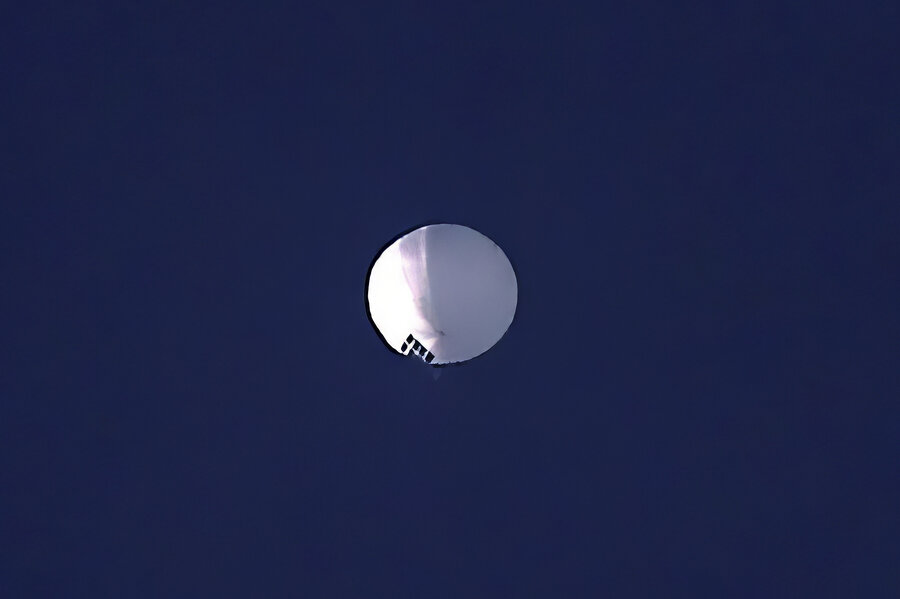Cloud reader or spy balloon? China downplays 'civilian airship' in US.
Loading...
| Beijing
China said Friday that a balloon spotted over American airspace was used for weather research and was blown off course, despite U.S. suspicion it was spying. The discovery further strained already tense relations between Beijing and Washington.
The Pentagon decided not to shoot down the balloon, which was potentially flying over sensitive sites, because of concerns about hurting people on the ground.
The news came as U.S. Secretary of State Antony Blinken was expected to make his first trip to Beijing this weekend. The visit has not been formally announced, and it was not immediately clear if the balloon’s discovery would affect his travel plans. Chinese Foreign Ministry spokesperson Mao Ning said she had no information on the trip.
Mr. Blinken would be the highest-ranking member of President Joe Biden’s administration to visit China, on a mission to mitigate a sharp downturn in relations between the countries amid trade disputes and concerns about Beijing’s increasingly aggressive stance toward Taiwan and in the South China Sea.
In a statement late Friday, the Chinese Foreign Ministry said the balloon was a civilian airship used mainly for meteorological research. The ministry said the airship has limited steering capabilities and “deviated far from its planned course” because of winds.
“The Chinese side regrets the unintended entry of the airship into U.S. airspace due to force majeure,” the statement said, citing a legal term used to refer to events beyond one’s control.
On Thursday, a senior American defense official told Pentagon reporters that the United States has “very high confidence” that the object spotted over U.S. airspace in recent days was a Chinese high-altitude balloon and that it was flying over sensitive sites to collect information. One of the places the balloon was spotted was Montana, which is home to one of the nation’s three nuclear missile silo fields at Malmstrom Air Force Base. The official spoke on condition of anonymity to discuss sensitive information.
The defense official said the U.S. has assessed that the balloon has “limited” value in terms of providing intelligence that couldn’t be obtained by other technologies, such as spy satellites.
It was not clear what will happen with the balloon if it isn’t brought down.
Pentagon press secretary Brig. Gen. Patrick Ryder said Thursday that similar balloon activity has been seen in the past several years and the government has taken steps to ensure no sensitive information was stolen.
He said the balloon was traveling well above the height commercial aircraft fly at and didn’t present a threat to people on the ground.
Mr. Biden was briefed and asked the military to present options, according to a senior administration official, who was also not authorized to publicly discuss sensitive information. The senior defense official said the U.S. prepared fighter jets, including F-22s, to shoot down the balloon if ordered.
Defense Secretary Lloyd Austin and Army Gen. Mark Milley, chairman of the Joint Chiefs of Staff, advised against taking “kinetic action” because of risks to the safety of people on the ground. Mr. Biden accepted that recommendation.
Even though the balloon was over a sparsely populated area of Montana, its size would create a debris field large enough that it could have put people at risk.
The defense official would not specify the size of the balloon but said commercial pilots could spot it from their cockpits.
The balloon was first reported by NBC News.
A photograph of a large white balloon lingering over the area was captured by The Billings Gazette. It could be seen drifting in and out of clouds and had what appeared to be a solar array hanging from the bottom, said Gazette photographer Larry Mayer.
The balloon’s appearance adds to national security concerns among American lawmakers over China’s influence in the U.S., ranging from the prevalence of the hugely popular smartphone app TikTok to purchases of American farmland.
“China’s brazen disregard for U.S. sovereignty is a destabilizing action that must be addressed,” Republican Party House Speaker Kevin McCarthy tweeted.
Tensions with China are particularly high on numerous issues, ranging from Taiwan and the South China Sea to human rights in China’s western Xinjiang region and the clampdown on democracy activists in Hong Kong. Not least on that list of irritants are China’s tacit support for Russia’s invasion of Ukraine, its refusal to rein in North Korea’s expanding ballistic missile program, and ongoing disputes over trade and technology.
On Tuesday, Taiwan scrambled fighter jets, put its navy on alert, and activated missile systems in response to nearby operations by 34 Chinese military aircraft and nine warships that are part of Beijing’s strategy to unsettle and intimidate the self-governing island democracy.
Twenty of those aircraft crossed the central line in the Taiwan Strait that has long been an unofficial buffer zone between the two sides, which separated during a civil war in 1949.
Beijing has also increased preparations for a potential blockade or military action against Taiwan, which has stirred increasing concern among military leaders, diplomats, and elected officials in the U.S., Taiwan’s key ally.
This story was reported by The Associated Press. AP writers Matthew Lee, Aamer Madhani and Zeke Miller in Washington and Matthew Brown in Billings, Montana, contributed to this report.





